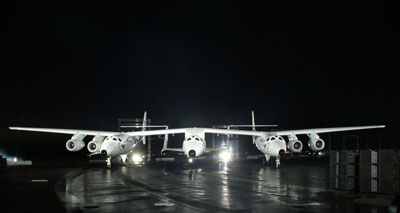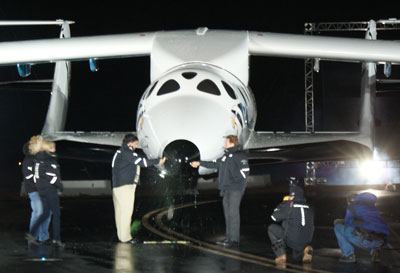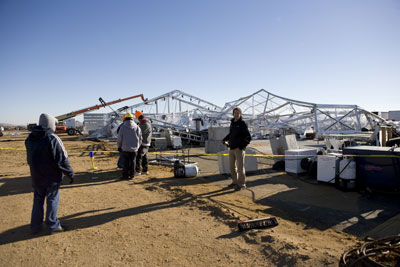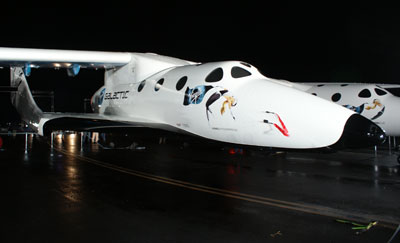Blown awayby Jeff Foust
|
| “Today represents the biggest milestone to date in every way, but it comes at an end of a year of other significant milestones,” said Attenborough. |
So when Virgin Galactic was ready to unveil SpaceShipTwo, its suborbital passenger spacecraft, it wasn’t simply going to roll it out of the hangar. Instead, it invited 800 people, from the media and its customers (dubbed “future astronauts”) to various other VIPs, to an elaborate set of tents built at the end of one of the runways at Mojave Air and Space Port, 150 kilometers north of Los Angeles. It was there on December 7 that Virgin put on an event designed to blow away its guests—and it did so, almost literally.
The unveiling was not a major news event in and of itself: the design of SpaceShipTwo was well known, having been released at another Virgin event in New York in January 2008. Instead, the event was more of a celebration of what the company had accomplished to date, and what it promised to do in the years to come.
“Today represents the biggest milestone to date in every way, but it comes at an end of a year of other significant milestones. 2009 really has been a year of firsts,” said Stephen Attenborough, commercial director of Virgin Galactic. He cited the series of tests flights by WhiteKnightTwo, the carrier aircraft for SpaceShipTwo; tests of the hybrid rocket motor that will power SpaceShipTwo on its suborbital ascent; and the groundbreaking in June of Spaceport America, the facility that will serve as Virgin’s base of operations when commercial service begins (see “Launching a spaceport”, The Space Review, June 22, 2009).
Attenborough also cited the company’s financial strength despite the current recession. “It did enable us to demonstrate pretty forcibly the fundamental commercial strength of our business, and of the new private manned space industry,” he said. Virgin Galactic, despite the steep recession, claimed a “substantial net increase” of customers, with over 300 now signed up and $42 million in deposits. (Virgin reported “nearly” 300 customers and $39 million in deposits in February.) “Now that may not sound like a lot of growth this year,” Attenbourough said, “but in a period where just about every business in the developed world is contracting at an almost unimaginable pace, the space tourism market proved itself vibrant and robust.”
 The WhiteKnightTwo airplane, carrying SpaceShipTwo between its twin fuselages, taxis into position at the rollout. (credit: J. Foust) |
That “fundamental commercial strength” was not always obvious, though, as Burt Rutan, founder of Scaled Composites, recalled in a speech at the unveiling. “At the end of our three-and-a-half-year program for Paul Allen on SpaceShipOne, I was really troubled by a big problem in front of me, and that is: what are we going to next and how is it possible to do anything next?” he recalled. He wasn’t sure there was a customer who had the “passion of spaceflight” and the necessary mindset and experience needed to turn the experimental SpaceShipOne into a commercial system.
“I actually went out and talked to folks from United and JetBlue” and asked those airlines if they would be interested in commercial spaceflight, Rutan said. “They looked at me like I was from Mars.” It was only later, when he met with Branson on the eve of SpaceShipOne’s first suborbital spaceflight, did he find that customer he was looking for to develop what would become SpaceShipTwo.
The development of SpaceShipTwo, though, has not been trouble-free. An explosion during a propulsion system test in July 2007 killed three Scaled employees and injured three others, and set back overall development of the system. “This program has been harder than we thought it would be. It’s taken longer, it’s been more difficult,” Rutan said.
| “There’s a lot of cool things you get to do when you’re governor,” Gov. Schwarzenegger said. “But this today is definitely one of the coolest things I have ever done.” |
Later, Rutan said that the difficulty in the program was due at least in part to the transition from an experimental program to the planned production of multiple spacecraft and aircraft. “While we’ve been involved with other customers who have built multiple versions of the type [of specific aircraft], this particular program is unique in that we are needing to flow our equipment and our instructions for building this ship directly to a manufacturing concern,” he said, referring to The Spaceship Company (TSC), the joint venture of Scaled and Virgin. “This is the first time where we’ve built a research prototype and, when we have the research prototype completed, we also have a string of production tooling, and that tooling is then available for TSC to begin the manufacture of the other ships.”
Now, though, the program is ready to move on to the flight test phase. Rutan didn’t disclose details about when those flight tests would begin or how long they would last, but did state that the test program would be similar to what Scaled did with SpaceShipOne. That effort started with “captive carry” flights, with SpaceShipOne remaining attached to its carrier aircraft, White Knight. Those were followed by glide tests, where SpaceShipOne was released from White Knight in flight and allowed to glide back to the ground, and eventually a series of powered test flights leading to its suborbital space flights.
After over an hour of speeches, it was time for the main event: the appearance of that first SpaceShipTwo. “So we had to find a name for our first SpaceShipTwo, to take up the test and experimental mantle of this unique commercial project,” Virgin Galactic president Will Whitehorn said. “But there was only one choice of name”: the Virgin Space Ship (VSS) Enterprise. He acknowledged they selected this name in part because of its legacy in the Star Trek series, where it became “a watchword for the very concept of human endeavor in space.”
The event took place late in the day, so that by the time of the unveiling darkness had fallen on Mojave. The audience somewhat reluctantly exited the tents to go outside, where temperatures were around freezing and gusty winds made it feel much colder. Few, though, complained about the cold when WhiteKnightTwo taxied into the spotlights, with SpaceShipTwo attached under its wing and between its twin fuselages.
 New Mexico governor Bill Richardson (left) and California governor Arnold Schwarzenegger formally christen the first SpaceShipTwo the VSS Enterprise. (credit: J. Foust) |
“Isn’t it the sexiest spaceship you’ve ever seen?” exclaimed Branson when SpaceShipTwo appeared to a cheering crowd. The spacecraft was then formally christened the VSS Enterprise by two guests of honor: California governor Arnold Schwarzenegger and New Mexico governor Bill Richardson.
“There’s a lot of cool things you get to do when you’re governor,” Schwarzenegger said prior to the unveiling. “But this today is definitely one of the coolest things I have ever done.” How cool? “To go and unveil the world’s first human commercial spacecraft even made my kids very jealous. And I have to tell you: my kids don’t like my job.”
The plan after the unveiling was to return to the tents and party the night away in true Virgin style, complete with an “IceBar” hosted by Absolut and the Swedish Icehotel (which is located near the site of Spaceport Sweden, expected to be where Virgin Galactic expands next after Spaceport America.) However, just a couple hours after the unveiling, with the party just getting into full swing, came a factor beyond the control of Virgin: the weather.
| Branson on the storm: “We were fully expecting to be blown away by our beautiful new spaceship but got a little more than we bargained for!” |
Throughout the day the weather in Mojave had been dismal: cold temperatures, winds, and occasional rain (with snow at elevations not much higher than Mojave.) While the rollout itself was dry, if cold, as the evening progressed the winds grew stronger. A little after 7:30 pm, a couple hours after the unveiling and an hour after WhiteKnightTwo and SpaceShipTwo headed back to their hangar, the emcee of the event made an announcement: everyone needed to evacuate the tents and board buses to return home because of a high wind warning.
That decision was a wise one. Wind gusts soon reached hurricane force and, a little over half an hour after the announcement, the main tent was demolished by the winds. Fortunately, everyone had been cleared from the site and no one was injured. Virgin said in a later release that the winds had reached 187 km/h (116 mph). As Branson put it in that later statement: “We were fully expecting to be blown away by our beautiful new spaceship but got a little more than we bargained for!”
 The remnants of the tents that hosted the SpaceShipTwo rollout the day after the event, and the storm that ripped them apart. (credit: Virgin Galactic) |
While the winds wiped out the tents and the party, it didn’t appear to dash the enthusiasm of Virgin Galactic or its guests, many of whom are looking forward to the day when they’ll get blown away not by a gust of wind but by the experience of a lifetime: a trip into space. With the unveiling of SpaceShipTwo—now no longer an artist’s conception but instead a real, physical vehicle—that possibility is one step closer to reality.
